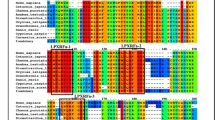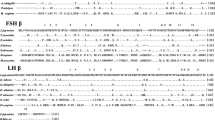Abstract
Glycoprotein hormones, follicle-stimulating hormones (FSHs), luteinizing hormones (LHs), thyroid-stimulating hormones (TSHs), and chorionic gonadotropin (CG) are key endocrine hormones secreted from the pituitary gonadotrophs and thyrotrophs and the placenta in primates. These hormones, consisting of a common alpha subunit and a specific beta subunit, act through the FSH receptor (FSHR), the LH receptor (LHR), and the TSH receptor (TSHR) that are highly specific for their cognate hormones. These glycoprotein hormones are structurally and functionally conserved in various vertebrates and have been identified in most lineages of actinopterygians (bony fish) and sarcopterygians (tetrapods). Of interest, recent genomic studies showed that vertebrate glycoprotein hormone receptors belong to an ancient subfamily of G protein-coupled receptors (GPCRs) named as leucine-rich repeat-containing GPCRs (LGRs). These findings have prompted the hypothesis that there could be additional glycoprotein hormones in vertebrate genomes. Indeed, searches of vertebrate genomes have led to the identification of two novel glycoprotein hormone subunits, glycoprotein alpha 2 (GPA2) and glycoprotein beta 5 (GPB5), as well as their homologs in invertebrates. Subsequently, it was demonstrated that GPA2 and GPB5 form a heterodimeric hormone, thyrostimulin/OGH, capable of activating TSHR in vivo and the thyroid axis in transgenic mice. However, the exact role of this novel glycoprotein hormone and its homolog in invertebrates is not clear. To gain a better understanding of the physiological role of the novel glycoprotein hormone subunits and their evolution, it is imperative to carry out systematic studies of these genes in representative model species. In the present report, we summarize our findings based on studies of genomes of model organisms from sea anemones to humans. We found that GPA2 and GPB5 represent the ancient forms of glycoprotein hormone alpha and beta subunits, respectively, and that vertebrate and invertebrate glycoprotein hormone subunit proteins shared common ancestors that evolved during early metazoan evolution. It is important to note that glycoprotein hormone alpha and beta subunit proteins from invertebrates formed a heterodimer with structural functional characteristics similar to that of vertebrate glycoprotein hormones. Taken together, both glycoprotein hormone alpha and beta subunits evolved before the evolution of nematodes, arthropods, and vertebrates. Parallel expansion of the alpha and beta subunits and their receptors through gene duplication and subsequent subfunctionalization and neofunctionalization of the duplicated genes allowed the development of multiple tissue-specific endocrine systems in vertebrates.
Similar content being viewed by others
References
Hearn, M. T. and Gomme, P. T. (2000). J. Mol. Recognit. 13, 223–278.
Isaacs, N. W. (1995). Curr. Opin. Struct. Biol. 5, 391–395.
Kol, S. and Adashi, E. Y. (1995). Curr. Opin. Obstet. Gynecol. 7, 209–213.
Jameson, J. L. (1996). Mol. Cell. Endocrinol. 125, 143–149.
Achermann, J. C. and Jameson, J. L. (1999). Mol. Endocrinol. 13, 812–818.
Hsueh, A. J., Eisenhauer, K., Chun, S. Y., Hsu, S. Y., and Billig, H. (1996). Recent Prog. Horm. Res. 51, 433–455.
Themmen, A. P. N. and Huhtaniemi, I. T. (2000). Endocr. Rev. 21, 551–583.
Puett, D., Bhowmick, N., Fernandez, L. M., Huang, J., Wu, C., and Narayan, P. (1996). Mol. Cell. Endocrinol. 125, 55–64.
Huhtaniemi, I. (2000). Horm. Res. 53, 9–16.
Hai, M. V., De Roux, N., Ghinea, N., et al. (1999). Ann. Endocrinol. (Paris) 60, 89–92.
Brown, R. S. (2004). Endocrinology 145, 4058–4061.
Vassart, G., Pardo, L., and Costagliola, S. (2004). Trends Biochem. Sci. 29, 119–126.
Milgrom, E. (2003). Bull. Acad. Natl. Med. 187, 671–680; discussion 680–682.
Rodien, P., Ho, S. C., Vlaeminck, V., Vassart, G., and Costagliola, S. (2003). Ann. Endocrinol. (Paris) 64, 12–16.
Wonerow, P., Neumann, S., Gudermann, T., and Paschke, R. (2001). J. Mol. Med. 79, 707–721.
Boime, I. and Ben-Menahem, D. (1999). Recent Prog. Horm. Res. 54, 271–288.
Corless, C. L., Matzuk, M. M., Ramabhadran, T. V., Krichevsky, A., and Boime, I. (1987). J. Cell. Biol. 104, 1173–1181.
So, W. K., Kwok, H. F., and Ge, W. (2005). Biol. Reprod. PMID: 15728794.
Kwok, H. F., So, W. K., Wang, Y., and Ge, W. (2005). Biol. Reprod. PMID: 15728795.
Querat, B., Sellouk, A., and Salmon, C. (2000). Biol. Reprod. 63, 222–228.
Laan, M., Richmond, H., He, C., and Campbell, R. K. (2002). Gen. Comp. Endocrinol. 125, 349–364.
Ryan, R. J., Charlesworth, M. C., McCormick, D. J., Milius, R. P., and Keutmann, H. T. (1988). FASEB J. 2, 2661–2669.
Keutmann, H. T. (1992). Mol. Cell Endocrinol. 86, C1-C6.
Segaloff, D. L., Sprengel, R., Nikolics, K., and Ascoli, M. (1990). Recent Prog. Horm. Res. 46, 261–301.
Milgrom, E., de Roux, N., Ghinea, N., et al. (1997). Horm. Res. 48, 33–37.
Lustbader, J. W., Lobel, L., Wu, H., and Elliott, M. M. (1998). Recent Prog. Horm. Res. 53, 395–424.
Zeleznik, A. J. (1998). Proc. Natl. Acad. Sci. USA 95, 11002–11007.
Kaivo-Oja, N., Bondestam, J., Kamarainen, M., et al. (2003). J. Clin. Endocrinol. Metab. 88, 755–762.
Vitt, U. A., Hsu, S. Y., and Hsueh, A. J. (2001). Mol. Endocrinol. 15, 681–694.
Wu, H., Lustbader, J. W., Liu, Y., Canfield, R. E., and Hendrickson, W. A. (1994). Structure 2, 545–558.
Lapthorn, A. J., Harris, D. C., Littlejohn, A., et al. (1994). Nature 369, 455–461.
Hsu, S. Y., Nakabayashi, K., and Bhalla, A. (2002). Mol. Endocrinol. 16, 1538–1551.
Nothacker, H. P. and Grimmelikhuijzen, C. J. (1993). Biochem. Biophys. Res. Commun. 197, 1062–1069.
Eriksen, K. K., Hauser, F., Schiott, M., Pedersen, K. M., Sondergaard, L., and Grimmelikhuijzen, C. J. (2000). Genome Res. 10, 924–938.
Nishi, S., Hsu, S. Y., Zell, K., and Hsueh, A. J. (2000). Endocrinology 141, 4081–4090.
Hsu, S. Y., Kudo, M., Chen, T., et al. (2000). Mol. Endocrinol. 14, 1257–1271.
Hsu, S. Y., Liang, S. G., and Hsueh, A. J. (1998). Mol. Endocrinol. 12, 1830–1845.
Tensen, C. P., Van Kesteren, E. R., Planta, R. J., et al. (1994). Proc. Natl. Acad. Sci. USA 91, 4816–4820.
Krajnc-Franken, M. A., van Disseldorp, A. J., Koenders, J. E., Mosselman, S., van Duin, M., and Gossen, J. A. (2004). Mol. Cell Biol. 24, 687–696.
Hsu, S. Y. (2003). Trends Endocrinol. Metab. 14, 303–309.
Hsu, S. Y., Nakabayashi, K., Nishi, S., et al. (2002). Science 295, 671–674.
Kawamura, K., Kumagai, J., Sudo, S., et al. (2004). Proc. Natl. Acad. Sci. USA 101, 7323–7328.
Kamat, A. A., Feng, S., Bogatcheva, N. V., Truong, A., Bishop, C. E., and Agoulnik, A. I. (2004). Endocrinology 145, 4712–4720.
Bogatcheva, N. V., Truong, A., Feng, S., Engel, W., Adham, I. M., and Agoulnik, A. I. (2003). Mol. Endocrinol. 17, 2639–2646.
Sudo, S., Kumagai, J., Nishi, S., et al. (2002). J. Biol. Chem. 278, 7855–7862.
Luo, C. W., Dewey, E. M., Sudo, S., et al. (2005). Proc. Natl. Acad. Sci. USA 102, 2820–2825.
Mendive, F. M., Loy, T. V., Claeysen, S., et al. (2005). FEBS Lett. 579, 2171–2176.
Herpin, A., Badariotti, F., Rodet, F., and Favrel, P. (2004). Biochim. Biophys. Acta 1680, 137–144.
Nishi, S., Hsu, S. Y., Zell, K., and Hsueh, A. J. (2000). Endocrinology 141, 4081–4090.
Eriksen, K. K., Hauser, F., Schiott, M., Pedersen, K. M., Sondergaard, L., and Grimmelikhuijzen, C. J. (2000). Genome Res. 10, 924–938.
Dewey, E. M., McNabb, S. L., Ewer, J., et al. (2004). Curr. Biol. 14, 1208–1213.
Honegger, H. W., Dewey, E. M., and Kostron, B. (2004). Acta Biol. Hung. 55, 91–102.
Nakabayashi, K., Matsumi, H., Bhalla, A., et al. (2002). J. Clin. Invest. 109, 1445–1452.
Macdonald, L. E., Wortley, K. E., Gowen, L. C., et al. (2005). Proc. Natl. Acad. Sci. USA 102, 2496–2501.
Erbel, P. J., Karimi-Nejad, Y., De Beer, T., Boelens, R., Kamerling, J. P., and Vliegenthart, J. F. (1999). Eur. J. Biochem. 260, 490–498.
Hewes, R. S. and Taghert, P. H. (2001). Genome Res. 11, 1126–1142.
Takeda, S., Kadowaki, S., Haga, T., Takaesu, H., and Mitaku, S. (2002). FEBS Lett. 520, 97–101.
Zhang, X. and Firestein, S. (2002). Nat. Neurosci. 5, 124–133.
Force, A., Lynch, M., Pickett, F. B., Amores, A., Yan, Y. L., and Postlethwait, J. (1999). Genetics 151, 1531–1545.
Sudo, S., Kuwabara, Y., Park, J. L., Hsu, S. Y., and Hsueh, A. J. (2005). Endocrinology, in press.
Author information
Authors and Affiliations
Corresponding author
Rights and permissions
About this article
Cite this article
Park, JI., Semyonov, J., Chang, C.L. et al. Conservation of the heterodimeric glycoprotein hormone subunit family proteins and the LGR signaling system from nematodes to humans. Endocr 26, 267–276 (2005). https://doi.org/10.1385/ENDO:26:3:267
Received:
Issue Date:
DOI: https://doi.org/10.1385/ENDO:26:3:267




